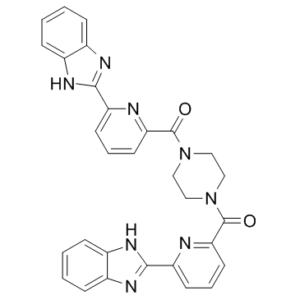This product is for research use only, not for human use. We do not sell to patients.

| Size | Price | Stock |
|---|---|---|
| 5mg | $95 | 3-6 Days |
| 10mg | $140 | 3-6 Days |
| 25mg | $220 | 3-6 Days |
| 50mg | $400 | 3-6 Days |
| 100mg | $750 | 3-6 Days |
| 250mg | $1450 | 3-6 Days |
Cat #: V2989 CAS #: 1912399-75-7 Purity ≥ 98%
Description: This product is discontinued due to commercial reason. BT-11 is a first-in-class, potent, orally available and selective modulator of LANCL2 (Lanthionine synthetase C-like 2) which is a novel therapeutic target for inflammatory and autoimmune diseases and diabetes, exerts anti-inflammatory and insulin-sensitizing effects. BT-11 at high doses has an excellent safety profile up to 1000 mg/kg/day. It has demonstrated therapeutic efficacy in 3 validated mouse models of colitis at doses as low as 8 mg/kg/d; It protects from IBD by targeting LANCL2. BT-11 has potential to be a safe and effective orally active therapeutic for IBD. The oral treatment with BT-11 (8 mg/kg/d) in a mouse model of IBD resulted in lowering the disease activity index, decreasing colonic inflammatory lesions by 4-fold, and suppressing inflammatory markers (e.g., TNF-α, and interferon-γ) in the gut. Furthermore, studies in LANCL2-/- mice demonstrated that loss of LANCL2 abrogated beneficial actions of BT-11, suggesting high selectivity for the target. In conclusion, BT-11 merits continued development as a LANCL2-based, first-in-class orally active therapeutic for IBD.
Publications Citing InvivoChem Products
Product Promise

- Physicochemical and Storage Information
- Protocol
- Related Biological Data
- Stock Solution Preparation
- Quality Control Documentation
| Molecular Weight (MW) | 528.2 |
|---|---|
| Molecular Formula | C30H24N8O2 |
| CAS No. | 1912399-75-7 |
| Storage | -20℃ for 3 years in powder form |
| -80℃ for 2 years in solvent | |
| Solubility In Vitro | DMSO: ≥ 30 mg/mL |
| Water: <1 mg/mL | |
| Ethanol: <1 mg/mL | |
| Solubility In Vivo | O=C(N1CCN(C(C2=NC(C3=NC4=CC=CC=C4N3)=CC=C2)=O)CC1)C5=NC(C6=NC7=CC=CC=C7N6)=CC=C5 |
| Synonyms | BT-11; BT 11; BT11 |
| Protocol | In Vitro | In vitro activity: BT-11 is a first-in-class, potent, orally available and selective modulator of LANCL2 (Lanthionine synthetase C-like 2) which is a novel therapeutic target for inflammatory and autoimmune diseases and diabetes, exerts anti-inflammatory and insulin-sensitizing effects. BT-11 at high doses has an excellent safety profile up to 1000 mg/kg/day. It has demonstrated therapeutic efficacy in 3 validated mouse models of colitis at doses as low as 8 mg/kg/d; It protects from IBD by targeting LANCL2. BT-11 has potential to be a safe and effective orally active therapeutic for IBD. The oral treatment with BT-11 (8 mg/kg/d) in a mouse model of IBD resulted in lowering the disease activity index, decreasing colonic inflammatory lesions by 4-fold, and suppressing inflammatory markers (e.g., TNF-α, and interferon-γ) in the gut. Furthermore, studies in LANCL2-/- mice demonstrated that loss of LANCL2 abrogated beneficial actions of BT-11, suggesting high selectivity for the target. In conclusion, BT-11 merits continued development as a LANCL2-based, first-in-class orally active therapeutic for IBD. Kinase Assay: LANCL2 engagement produces an increase of PKA, followed by an accumulation of cAMP in the cytoplasm. BT-11 treatment splenocytes shows a dose−response increase of cAMP production. BT-11 stimulates cAMP production by activating the LANCL2 pathway. |
|---|---|---|
| In Vivo | Oral treatment with BT-11 at 8 mg/kg/d in a mouse model of inflammatory bowel disease results in lowering the disease activity index, decreasing colonic inflammatory lesions by 4-fold, and suppressing inflammatory markers (e.g., TNF-α, and interferon-γ) in the gut. Furthermore, studies in LANCL2−/− mice demonstrates that loss of LANCL2 abrogates beneficial actions of BT-11, suggesting high selectivity for the target. Oral treatment with BT-11 (8 mg/kg/day) ameliorates colitis in mice. Initial safety assessment in rats indicates that oral treatment with BT-11 at high doses has an excellent safety profile up to 1000 mg/kg/day[1]. BT-11 is well tolerated in rats, and may hold promise as an orally active therapeutic for Crohn’s disease. One hour after oral administration of a single dose of 80 mg/kg, BT-11 has a maximal concentration of 21 ng/mL; the half-life is 3 hours | |
| Animal model | Male Harlan Sprague Dawley rats and Wild type and LANCL2−/− male mice with IBD models |
| Solvent volume to be added | Mass (the weight of a compound) | |||
|---|---|---|---|---|
| Mother liquor concentration | 1mg | 5mg | 10mg | 20mg |
| 1mM | 1.8932 mL | 9.4661 mL | 18.9322 mL | 37.8644 mL |
| 5mM | 0.3786 mL | 1.8932 mL | 3.7864 mL | 7.5729 mL |
| 10mM | 0.1893 mL | 0.9466 mL | 1.8932 mL | 3.7864 mL |
| 20mM | 0.0947 mL | 0.4733 mL | 0.9466 mL | 1.8932 mL |
This equation is commonly abbreviated as: C1 V1 = C2 V2
- (1) Please be sure that the solution is clear before the addition of next solvent. Dissolution methods like vortex, ultrasound or warming and heat may be used to aid dissolving.
- (2) Be sure to add the solvent(s) in order.




































